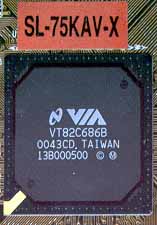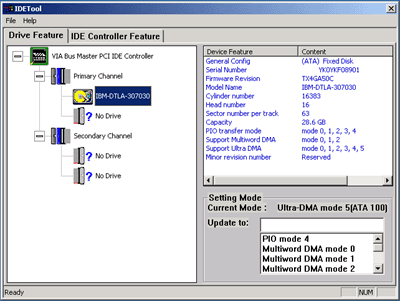VIA’s KT133A Socket-A Chipset: AMD 760 Performance without DDR SDRAM
by Anand Lal Shimpi on December 21, 2000 3:34 PM EST- Posted in
- CPUs
The KT133 learns new tricks
 Originally
the KT133 chipset was supposed to have support for the 133MHz FSB, however we
quickly realized that as a direct descendent of the KX133 chipset that wouldn’t
work at anything above 110 – 115MHz, the KT133 wouldn’t be able to either.
Originally
the KT133 chipset was supposed to have support for the 133MHz FSB, however we
quickly realized that as a direct descendent of the KX133 chipset that wouldn’t
work at anything above 110 – 115MHz, the KT133 wouldn’t be able to either.
According to VIA, this was a conscious decision on their part to limit the possibility of people playing around with the setting. However the more likely explanation is that for a motherboard manufacturer to support the 133MHz DDR FSB they need to take more into account during the design stage since the FSB will essentially be transferring as much data as a 266MHz FSB would. In order to keep costs down and shipments up until motherboard manufacturers were experienced enough with the Athlon platform and the new VIA chipsets, the designs they implemented were most likely castrated to support no more than the 100MHz FSB setting. As is the case with most designs however, users found that a 10% FSB overclock was generally possible.
The KT133A obviously offers full support for the 133MHz FSB that, being a DDR FSB, provides an effective 2.1GB/s of available bandwidth (133MHz x 2 x 64-bit wide bus). Other than the official support for the 133MHz FSB, the KT133A is no different than the regular KT133.
 While
the KT133A will work with all Southbridges that the KT133 worked with, chances
are that you won’t see any KT133A boards using the older 686A Southbridge.
Instead most will come with the 686B Southbridge that enables ATA/100 support.
While
the KT133A will work with all Southbridges that the KT133 worked with, chances
are that you won’t see any KT133A boards using the older 686A Southbridge.
Instead most will come with the 686B Southbridge that enables ATA/100 support.
However, as we noticed in our testing, the 686B Southbridge isn’t properly identified under Windows 2000 yet. Under Windows 98SE the 686B works fine and provides peak transfer rates identical to that of the i815E’s ATA/100 ICH2, however under Windows 2000 the performance of the IDE subsystem was in many cases, slower than that of a KT133 with the 686A Southbridge.
It seems as if VIA’s latest IDE drivers don’t properly recognize the 686B, however using the leaked beta 4.26 4-in-1 drivers (3011 IDE drivers) we managed to get the 686B to be properly recognized under Windows 2000. These new drivers also happen to have a new utility from VIA that is much like Intel’s Storage utility allowing you to set the transfer rate of the drives attached.
Windows 2000 still doesn’t properly support ATA/100 on non-Intel chipsets, so you won’t be able to get more than 66MB/s out of the 686B unless you’re running under Windows 98. With Windows 2000 Service Pack 2 already in beta, it shouldn’t be too much longer before this problem is fixed.











0 Comments
View All Comments